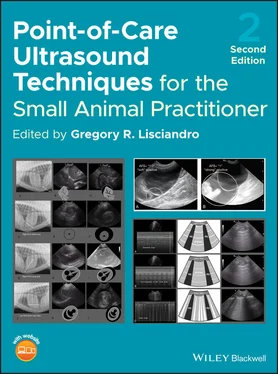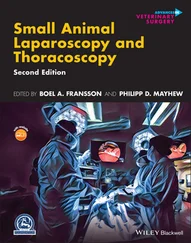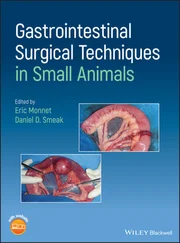Routine Add‐on of AFAST and Its Abdominal Fluid Scoring System (or Global FAST)
In the authors' experience, it is extremely valuable to perform an AFAST examination with assignment of an abdominal fluid score in either lateral recumbency for the best approach. The positioning of small animals in dorsal recumbency for POCUS abdominal organ examinations can obscure small‐volume peritoneal effusion and underestimate the volume of effusion present because peritoneal effusion will flow into the less sonographically accessible diaphragmatic recesses. AFAST improves the diagnostic potential of ultrasound by detecting peritoneal effusion. The early detection of abdominal effusion is clinically important and helps direct additional diagnostic recommendations while avoiding morbidity, complications, and patient mortality in the event the effusion is missed.
The Global FAST approach is used as a screening test to rapidly discriminate between localized and disseminated disease, comorbidities, and complications. Global FAST offers a rapid assessment of the abdomen (AFAST) and to survey for pleural and pericardial effusion (TFAST),and cardiac and pulmonary abnormalities (TFAST and Vet BLUE), including lung nodules, with minimal restraint upon initial patient triage.
Pearls and Pitfalls, The Final Say
It is important for the nonradiologist veterinarian to respect the limitations of the POCUS spleen examination because of the sonographic variability of many diffuse and nodular conditions. Fortunately, the spleen is amenable to minimally invasive cytological evaluation by percutaneous needle biopsy or aspirates when sonographic abnormalities are identified.
Although hemorrhage is an uncommon complication of percutaneous fine needle biopsy, the AFAST format with fluid scoring system (see Chapters 6and 7) is an excellent tool for postsampling monitoring (four hours post procedure and as needed thereafter), and is more sensitive than traditional means such as packed cell volume (hematocrit) for occult hemorrhage. Finally, a splenectomy with appropriate culture and histopathological testing may be required for definitive diagnosis and treatment plan, and the spleen may be surgically removed with little long‐term consequence in both dogs and cats. Global FAST is an especially helpful approach to rapidly survey for pleural and pericardial effusion, and cardiac and pulmonary abnormalities, and is used as a screening test to rapidly discriminate between localized and disseminated disease, comorbidities, and complications (see Chapters XX and XX).
Evaluation of splenomegaly is a subjective assessment in dogs unless splenic enlargement is severe.
Splenomegaly in cats is almost always due to pathology and warrants additional evaluation.
Nodular and mass lesions within the splenic parenchyma are common and usually easy to identify. It is not possible to distinguish benign and malignant processes without cytology or histopathology.
Splenic hematoma and hemangiosarcoma cannot be differentiated on the basis of ultrasound alone, and may be concurrent. However, use of the Global FAST approach is helpful to rapidly screen for localized versus disseminated disease.
If the origin of an abdominal mass is difficult to determine, move the patient from dorsal to lateral recumbency. By doing so, the liver and spleen will often separate from one another, helping to better determine the origin of the mass.
Needle visualization by ultrasound facilitates fine needle percutaneous biopsy of the spleen. Nonspecific cytology results with fine needle biopsy do not rule out the possibility of a malignant lesion, and further diagnostics are required. However, the use of the Global FAST approach is helpful to rapidly screen for localized versus disseminated disease.
Mild diffuse changes in echogenicity are subjective and can be challenging for the novice sonographer.
Remember the mnemonic “SLiCK” regarding the echogenicity between the spleen (S), liver (Li), and cortex of the kidney (CK). The echogenicity of the spleen is greater (brighter) than the liver, which is slightly greater (brighter) or isoechoic (same as) than the cortex of the kidney. For the feline, hepatic echogenicity is often compared to the adjacent falciform fat and the feline liver should be isoechoic to slightly hypoechoic to the falciform fat.
Several benign processes cause mild to moderate diffuse changes in echogenicity including extramedullary hematopoiesis, passive congestion, and antigenic stimulation.
Diffuse changes associated with lymphosarcoma or other myeloproliferative disorders can be variable in appearance and occasionally can be associated with a normal or unremarkable splenic appearance.
Fine needle percutaneous biopsies are indicated in cases of moderate to severe splenomegaly or in animals with diffuse changes in echogenicity.
Quick Reference of Normals and Rules of Thumb
Spleen size is subjective. A spleen that extends to a small or medium‐sized urinary bladder is considered enlarged.
A folded spleen in a cat is always as a general rule considered abnormal and indicates splenomegaly (Hecht 2008).
Normal cat spleen thickness is <10 mm (Reese et al. 2013).
Benign nodular hyperplasia usually consists of nodules that are of homogeneous echotexture being either hypoechoic or hyperechoic.
Single target lesions have a high predictive value for malignancy. When multiple target lesions are seen, the positive predictive value of malignancy increases from 74% to 81% (Cuccovillo and Lamb 2002).
Normal echogenicity rule of thumb: the spleen (S) is more echogenic (hyperechoic) than the liver (Li) which is the same or slightly more echogenic (brighter) than the cortex of the kidney (CK), remembered as S > Li ≥ CK or by the mnemonic “SLiCK.” For the feline, hepatic echogenicity is often compared to the adjacent falciform fat and the feline liver should be isoechoic to slightly hypoechoic to the falciform fat.
1 Crabtree AC, Spangler E, Beard D, et al. 2010. Diagnostic accuracy of gray‐scale ultrasonography for the detection of hepatic and splenic lymphoma in dogs. Vet Radiol Ultrasound 51(6):661–614.
2 Cuccovillo A, Lamb CR. 2002. Cellular features of sonographic target lesions of the liver and spleen in 21 dogs and a cat. Vet Radiol Ultrasound 43(3):275–278.
3 Fife WD, Samii VF, Drost JS, et al. 2004. Comparison between malignant and nonmalignant splenic masses in dogs using contrast enhanced computed tomography. Vet Radiol Ultrasound 45:289–297.
4 Hammond TN, Pesillo‐Crosby SA. 2008. Prevalence of hemangiosarcoma in anemic dogs with a splenic mass and hemoperitoneum requiring a transfusion: 71 cases (2003–2005). J Am Vet Med Assoc 232(4):553–558.
5 Hecht S. 2008. Spleen. In: Atlas of Small Animal Ultrasonography, edited by Penninck D, d’Anjou M. Ames: Blackwell Publishing, pp 263–280.
6 Laurenson MP, Hopper K, Herrera MA, et al. 2010. Concurrent diseases and conditions in dogs with splenic vein thrombosis. J Vet Intern Med 24:1298–1304.
7 Lisciandro GR. 2011. Abdominal and thoracic focused assessment with sonography for trauma, triage, and monitoring in small animals. J Vet Emerg Crit Care 21(2):104–122.
8 Lisciandro GR, Lagutchik MS, Mann KA, et al. 2009. Evaluation of an abdominal fluid scoring system determined using abdominal focused assessment with sonography for trauma in 101 dogs with motor vehicle trauma. J Vet Emerg Crit Care 19(5):426–437.
9 Mai W. 2006. The hilar perivenous hyperechoic triangle as a sign of acute splenic torsion in dogs. Vet Radiol Ultrasound 47(5):487–491.
10 Nyland TG, Mattoon JS, Herrgesell EJ, Wisner ER. 2002. Spleen. In: Small Animal Diagnostic Ultrasound, 2nd edition, edited by Nyland TG, Mattoon JS. Philadelphia: WB Saunders, pp 132–133.
Читать дальше












